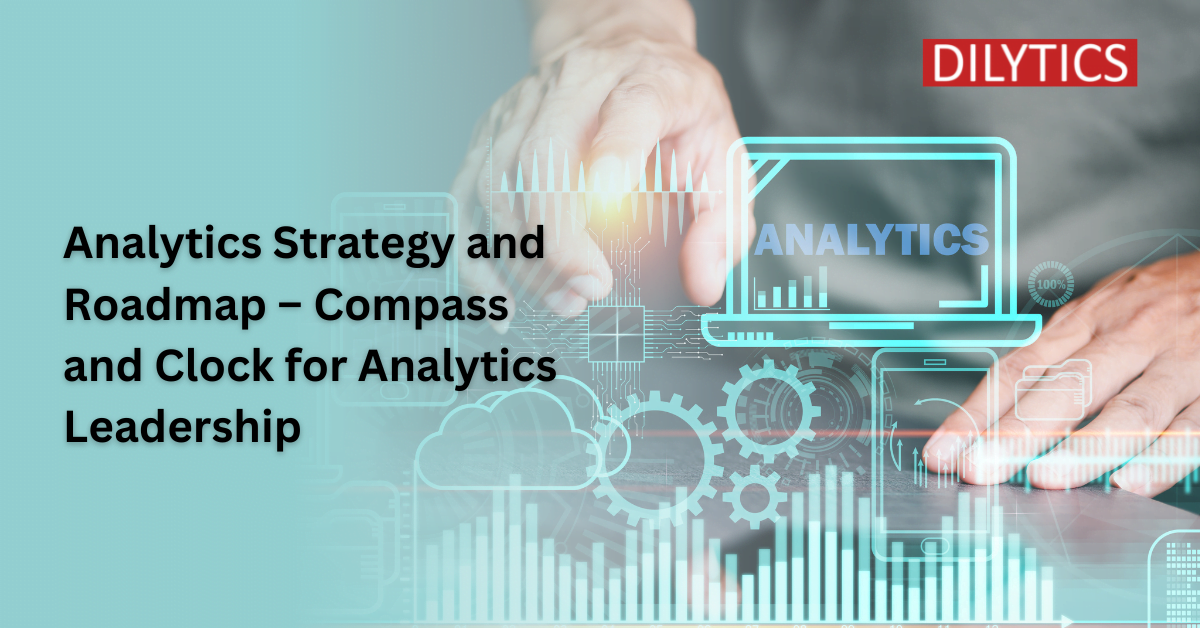It is said that leadership is like moving ahead with a ‘compass’ and a ‘clock’ – the compass tells if the direction is right and the clock tells how much time it will take to reach the destination.
The veracity of the above statement can be observed in the case of companies that recognize analytics as an integral constituent of their leadership ambition. For such companies, the ‘destination’ is ‘to become data-driven’; and to reach this destination, ‘strategy’ is the compass and ‘roadmap’ is the clock.
Having understood that analytics strategy and roadmap are important navigational tools for companies to achieve analytics leadership, let us understand what analytics strategy and roadmap are.
What is Analytics Strategy and Roadmap?
Analytics strategy is a company’s intent that specifies the people, process, and technology aspects that it should put in place to ensure that the right insights reach the right people at the right time to make the right decisions. An, analytics roadmap is the translation of an analytics strategy’s intent into a plan of action – that identifies the various initiatives that a company needs to undertake, evaluate the potential of each initiative, and outlines how and when they should be undertaken.
Why is Analytics Strategy and Roadmap Important?
It is important for companies to embark on the ‘Analytics Strategy and Roadmap’ exercise as it will enable them to channelize the power of analytics towards the achievement of their business goals. This is so because such an exercise provides a definitive goal and direction to a company’s efforts and investments in analytics. Its absence leads to a state best described by the famous quote from Lewis Carroll “If you don’t know where you want to go, any road will get you there.”
Further, it is imperative that the ‘analytics strategy and roadmap’ exercise is kept focussed on the necessary elements only so that the exercise is conducted economically, in quick time, and justifies the cost-benefit equation.
How to Embark on ‘Analytics Strategy and Roadmap’ Exercise?
Depicted below is the structured four-phase methodology that DiLytics follows in carrying out ‘Analytics Strategy and Roadmap’ exercise for customers:

DiLytics is of the firm conviction that the ‘Analytics Strategy and Roadmap’ exercise should be carried out in a structured and focused manner so that pertinent recommendations are arrived at and shared with customers quickly (in DiLytics experience, this exercise has been conducted in a matter of a few weeks). DiLytics methodology has been found to be a key enabler in ensuring this. The different phases in DiLytics methodology are described in more detail below:
Discovery
Key activities carried out in this phase are:
- Understand the client’s strategic business goals and specific measures of success.
- Validate scope w.r.t objects to be analyzed, KPIs and Metrics of interest, Reports and Dashboards, Data Warehouse, Data Sourcing, and Integration, Data and Object Security need
- Identify key stakeholders from the client’s business and IT teams.
- Conduct interviews at executive and department levels to understand the challenges faced and gain knowledge of what the client is trying to accomplish.
Analysis
Key activities carried out in this phase are:
- Identify data sources; how data is gathered, where it exists, roadblocks in accessing it.
- Know the client’s organizational structure; people skills; staff augmentation and training needs.
- Identify high-level business processes and the data needed to support them; how is data utilized in decision making.
- Assess the current platform utilized for data warehouse, data integration, and reporting; the extent to which the current operating system support analytics needs.
- Document findings and recommendations and share them with the client.
- Capture high-level functional and technical requirements; review them with the client.
Evaluation
Key activities carried out in this phase are:
- Prepare product evaluation criteria based on the multiple specifications including functional, technical, business, and cost.
- Assign weightages to evaluation criteria.
- Finalize the products to be evaluated – data warehouse, data integration, and reporting.
- Rate selected products against evaluation criteria.
- Provide product recommendations based on prioritized requirements and evaluation criteria.
Roadmap Creation
Key activities carried out in this phase are:
- Develop an implementation phasing strategy based on considerations such as the business objective, the criticality of requirements, ease of implementation, and dependency.
- For each phase, identify the activities, milestones, and deliverables.
- Estimate high-level timelines to implement each phase.
- Define talent and training needs for each phase of the implementation.
Conclusion
‘Analytics Strategy and Roadmap’ exercise is the foundation that every company should lay for guiding its various analytics initiatives towards successful completion. When viewed objectively, it is a small investment both in terms of money as well as time, which pays off manifold by streamlining the execution path of other larger-dollar-value analytics programs in a company.
DiLytics has extensive experience in helping companies determine the strategic direction for their analytics initiatives. For any queries related to this topic, please reach out to us at [email protected].





